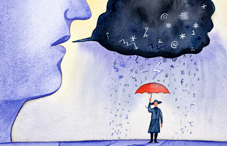 The expression “death by a thousand cuts” is used in the psychological literature to describe the many small, emotional blows we take in a lifetime. But for some colleagues at the Lab, these repeated cuts can add up to deeper wounds that are more difficult to heal.
The expression “death by a thousand cuts” is used in the psychological literature to describe the many small, emotional blows we take in a lifetime. But for some colleagues at the Lab, these repeated cuts can add up to deeper wounds that are more difficult to heal.
These little cuts are known as microaggressions, the everyday verbal and nonverbal slights, intentional or unintentional, that communicate a negative message. Think of them as the way implicit biases, which every one of us harbors, leak out of your psyche and into the world. Microaggressions are costly in several ways. They impact people’s ability to feel they can fully contribute or be part of a team, which results in loss of engagement, retention, productivity, and innovation.
Often microaggressions are based on a person’s membership in a category, including educational level, socio-economic status, gender, race, ethnicity, religion, LGBTQ+, disability, and age, among others.
Last year, the Lab’s Women Scientists and Engineers Council surveyed some of its members to ask about the gender-based microaggressions they had experienced at work. Seventy-five percent of the respondents reported that they had experienced at least one of these top five microaggressions:
- Frequent interruptions: This most often happens in meetings and small group interaction.
- He-peating: When a man suggests the same idea a woman contributed after her comment or suggestion was ignored.
- Mansplaining: When a man explains, usually in a condescending or patronizing manner, information which in fact the woman may be an expert in. It happens.
- Prove it again: Where someone needs to re-establish their credentials over and over.
- Jokes about diversity and work-life balance topics: If the comment made is followed by “it’s just a joke”, it probably wasn’t.
On the surface, each of these interactions may seem minor, but in the aggregate, they can add up to a problem for the recipient of the microaggressions. The recipient often does not respond due to fear of recrimination, fear of being labeled as “difficult” or “emotional,” or exhaustion from dealing with microaggressions on a regular basis. Repeated microaggressions can leave the recipient tired, burnt out, and discouraged. Watch this video about how microaggressions have affected your co-workers.
Here are some things you can do to halt microaggressions:
- Admit that microaggressions exist at the Lab, in the classroom, at conferences. They are real.
- Explore and educate yourself on the subject.
- Talk to family members about their own experiences with microaggressions. They may be different from yours.
- Listen to yourself at your next meeting.
- Stand-up for a co-worker who is the target of a microagression. This doesn’t need to be a confrontation, but there are simple ways you can support your colleague.
The Lab’s Diversity and Inclusion Office will be offering training for upstanders or those who recognize the situation and try to make it right. You can get a preview of that training in the next Brown Bag session, Tuesday, Dec. 17 at noon in Building 50, Room 4205.
